
Drawing by Matt Strieby [2016].
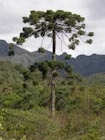
Mature tree in Parque Natural Caraça, Brazil. The trees are very rare and local here, on the northern edge of their range [Vladimir Dinets, 2008.01].

Canopy of mature A. angustifolia.

Forest of A. angustifolia in southern Brazil [Anamaria F. Stranz].
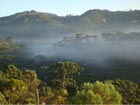
Native A. angustifolia forest in Campos do Jordao [Constance Price, 2009.04].
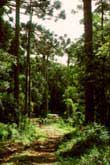
Managed stand of pinheiros.

Pollen cone from a tree in New Zealand. The size of the pollen cone sets this species apart from all similar species [C.J. Earle, 2003.03].

A branch rich with pollen cones. Mt. Tomah Botanic Garden, Australia [©Rick Fencl, 2017.11.22].
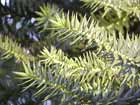
Foliage on open-grown ornamental tree, New Zealand [C.J. Earle, 2003.03].
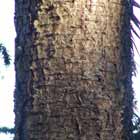
Bark on ornamental tree, 25 cm diameter, New Zealand [C.J. Earle, 2003.03].
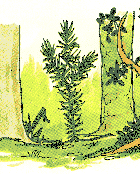
A seedling in the forest (SEEC 1996).
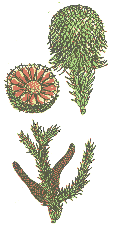
Seed (above) and pollen (below) cones (SEEC 1996).
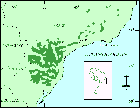
Distribution (Kershaw and Wagstaff 2001).
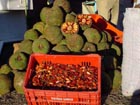
Harvested cones and seeds for sale [Universidade Federal do Rio Grande do Sur].
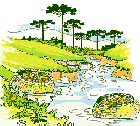
Baskets of nuts gathered by native people (SEEC 1996).
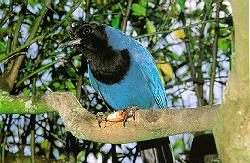
The blue gralha (Corvidae), state bird of Parana, is famous for his habit of planting pinheiro nuts. This sort of bird-tree symbiosis is common among many true pines (Pinus spp.), but I have not heard of it among other species of Araucaria.
Also see this Embrapa video, full of great images, in Portuguese.

Araucaria angustifolia
(Bertol.) Kuntze 1898
Common names
Portuguese: Pinheiro-do-Paraná, pinheiro, araucária, pinho, pinho Brasileiro, pinheiro Brasileiro, pinheiro são josé, pinheiro macaco, pinheiro caiová, pinheiro das missões, curi, curiúva; English: Parana pine or candelabra tree.
Taxonomic notes
Synonymy:
- Columbea angustifolia Bertol. 1819
- Araucaria brasiliana A. Rich. 1822
- Pinus dioica Vell. 1831
- Araucaria ridolfiana Pi. Savi 1846
- Araucaria elegans Hort. ex Carrière 1855
- Araucaria gracilis Hort. ex Carrière 1855
- Araucaria brasiliana var. ridolfiana (Pi. Savi) Gordon 1858
- Araucaria saviana Parl. 1861
- Columbea brasiliensis (A. Rich.) Carrière 1867
- Columbea brasiliensis var. ridolfiana (Pi. Savi) Carrière 1867
- Araucaria dioica (Vell.) Stellfeld 1944
- Araucaria angustifolia var. dependens J.R. de Mattos 1967
- Araucaria angustifolia var. vinacea J.R. de Mattos 1997
Several geographically distinct races have been described (citations in Sousa et al. 2004), but none are currently accepted. Sousa et al. (2004) performed a study of regional allozyme variation and found evidence of a latitudinal gradient, with 92% of variability between seed trees explained by differences in locality. They also reported no evidence of inbreeding or excess heterozygosity among seed trees.
Description
Dioecious trees 25–35(–52) m tall, with a straight trunk and horizontal branches, the crown becoming flat-topped with age. Bark finely scaly, resinous, striated horizontally. Branchlets arranged in whorls of 4–8. Leaves sharply acute, needle-like, lanceolate, midrib visible, usually in pairs, dark green or glaucous, thick, 30–60 mm long by 6 mm wide, stomata above, keeled below, tending to be tufted at outer ends of branches. Leaves on fertile branchlets densely disposed spirally, much shorter, denser, with prominent stomata below. Male cone dense, shortly extending beyond the axil of the leaves, 10–18 cm long by 1.2–2.5 cm wide, scales imbricate. Female cone globular, 18–25 cm long by 13 cm wide, chestnut-brown, maturing in 2–3 years, wet weight ca. 1 kg, scales with a long recurved bract or umbo. Seeds light brown, 50 mm long by 8–20 mm wide, with narrow wings. Germination hypogeal. Cotyledons 2 (Silba 1986, SEEC 1996).
Distribution and Ecology
Brazil: 500–1,500(–2,300) m elevation in subtropical forests, primarily in the states of Paraná, Santa Catarina, Rio Grande Do Sul, and locally in São Paulo, Minas Gerais and Rio De Janeiro; also N Argentina and Paraguay at 500–2,300 m. This range covers latitudes 19.25°S to 31.5°S, and longitudes 41.5°W to 54.5°W (SEEC 1996, Silba 1986, Sousa et al. 2004). This is the only Araucaria not native to the south Pacific Ocean region.
Climate is subtropical mesothermic. February is the warmest month (17–22°C) and July is the coldest (8–12°C), with absolute minimum temperatures reaching below 0°C. Rainfall ranges between 1,500 to 2,000 mm (Sousa et al. 2004). Hardy to Zone 9 (cold hardiness limit between -6.6°C and -1.1°C) (Bannister and Neuner 2001).
Around 1900 the species is estimated to have had an area of occupancy of ca. 20 million ha, of which only 565,419 ha remained by 1982. Logging at that time was still continuing at an estimated rate of 80,000 ha per year. This amounts to a forest reduction of over 97% within three tree generations. Plantation forestry with Pinus and Eucalyptus as well as other land uses have made restoration unlikely in much of the affected area; on the other hand plantation of pinheiro reached 90,000 ha in the mid 1990s. Logging of the species is now banned; if this ban remains in place and is effectively enforced, then the species may still be preserved (Farjon 2006). The largest remaining strongholds for the species are in the region of General Carneiro and Bituruna (SEEC 1996). The IUCN reports that this species is facing an extremely high risk of extinction in the wild due to declining population caused by habitat loss and exploitation.
Remarkable Specimens
An old sign by the big tree at the Parque do Pinheiro Grosso (29.3242°S, 50.85445°W) states that it is 48 m tall, 270 cm dbh, 1 m diameter at 13 m height, and has a wood volume of 120 cubic meters. This species is said to grow to 52 m tall (Mattos 1972), but trees of that size may have been logged out.
A web site dedicated to the big trees of this species is maintained by Marcelo Scipioni at http://m.arvoresgigantes.org/lista-de-arvores-gigantes2/araucaria/, providing detailed information on over 20 very large specimens. Also, see the letter in "Remarks" below.
No specific old trees are known. It is said to reach a maximum age of about 500 years (SEEC 1996).
Ethnobotany
Native Americans used to gather the cones and harvest the seeds for food. They would shoot the seeds down using blunted arrows, and bake the seeds before eating (SEEC 1996). Similar preparations attended use of bunya pine (A. bidwillii) by Australian Aboriginals. The pinheiro was, however, immediately recognized as a valuable timber tree when Europeans came to Brasil. Forest land grants began in 1511 and by the mid-18th century, the Araucaria forests were fast being cleared to provide timber for shipbuilding, construction and related uses. As in so much of the new world, though, the most destructive and extensive deforestation had to await the development of railroads and, later, large trucks. These enabled logging the bulk of the virgin pinheiro forests from the 1870's to the 1940's (SEEC 1996). Since that time, production has largely shifted to plantation forestry programs, for which purpose the species is planted not only in Brasil, but in subtropical environments across the globe.
The species has seen little work in dendrochronology. One study by Seitz and Kaaninen (1988) did some exploratory work on eight trees; results were encouraging but inconclusive. The species has also been used in C-14 calibration and detection studies, at least one stable isotope study, and recently in a series of solar variability studies (e.g., Rigozo et al. 2004).
Observations
Sousa et al. (2004) report three major conservation sites for the species:
- Campos do Jordão State Park in São Paulo State (22.733°S, 43.733°W, 1800 meters elevation), where the vegetation consists of native grassland and 5,655 hectares of forest. Podocarpus lambertii and Podocarpus sellowii are common trees, and there is abundant natural regeneration of A. angustifolia. Warning: Although there is a "Campos do Jordão State Park," it is located over 100 km from the cited location, at 22.683°S, 45.450°W. Other authorities also cite this location as important to the species' conservation.
- Irati National Park in Paraná State (25.500°S, 50.600°W, 880 meters elevation), where the forest covers 3,495 ha and is rich in Lauraceae species, characteristic of the Araucaria-Ocotea community. Local smaller forest remnants range from pioneer to late transition forest stages. Warning: Nobody but Sousa et al. (2004) identifies the existence of an "Irati National Park" and the location they cite is agricultural.
- Caçador National Park in Santa Catarina State (26.833°S, 51.000°W, 1100 meters elevation), where the forest covers 1,600 ha. The large emergent A. angustifolia trees dominate the upper canopy, but the species shows very low natural regeneration. Ocotea porosa, O. pretiosa, Cedrela fissilis, Sloanea lasiocoma, and other late successional angiosperm species characterize the main forest and local smaller remnants. Warning: Nobody but Sousa et al. (2004) identifies the existence of a "Caçador National Park" and the location they cite is grazing land with nearby plantation forestry. However, Santa Caterina does host the Parque Nacional de São Joaquim, famous for its A. angustifolia forests, located at about 28.2°S, 49.9°W.
Remarks
The seed cones, containing on average 120 seeds (pinhões), are eaten by people; by other mammals including agoutis, rats, preás, ouriços, serelepes and monkeys; and by birds including gralhas, maitacas, parrots, and tirivas (SEEC 1996).
On 2005.11.28 I received the following letter from Roberval Lech Guerreiro of Farol, Paraná. I am not inclined to translate Mr. Guerreiro's poetic English to American, so I will quote him directly:
I've found your web site when looking for other forest information ... Of course, my first driving was to Araucaria angustifolia, this beloved and at the same time so devastated tree that is really a part of my life, for which I actually have born in a house made of her timber, and grew up among her presence, eating pinhões every winter, and, somehow, amazed when got some skin cut and realized that my own blood is red, and not green, as those forests of the tales of my grandfather and other elders, those my dreams and those really ones all around my piazices (boyish). Neither green as my flag, and my best hopes and dreams for my descendents over this land, when they come to light.
I have on my own, if this may interest you, some more materials that could eventually complement your web site regarding this marvelous tree, which is no longer more than a shadow, from a so close past, that make me ashamed for having in our flag a grimpa of the tree we have so fiercely destructed. One is a picture we took in April of 2002, in Rio Grande do Sul highlands, among Gramado and Nova Friburgo, of a pinho in such a way big, that he escaped of the saws of the lumbers, for having no saw big enough for slicing him. I and two more friend, side by side, with that enormous tree after us. I mean, the tree trunk is really wider than our shoulders.
I remember some report of another giant pinho as big than that one, but to find they right now would be a project. Those ancient ones are supposed to be in the National Forest of Irati, in Chapecó, and in probably Francisco Beltrão, as I remember. The report tells about 3 meters of diameter and up to 70 meters high. Wonderfull and old growth trees can be found in city parks of Cascavel and Guarapuava.
I can assure you, and, eventually supporting with evidences, when time makes it possible, that the pinho seeds, pinhes, still being a part of our food and even of our economy. It's usually caught from the forest by less favored people, who then come to the roads, selling the pinhões and pinhas to the traveler, as to dealers, who supply the supermarkets at the cities. And what a pleasure to bring down a pinha from a grimpa, fells that pinho smell, which is really different of Pinus elliotii smell, take the pinhes from it, and cooking in salt water, or baking in a sapecada. Sapecada is a traditional way for baking the pinhes using dried grimpas as fuel. My grandfather had this for food, completed with some hunting flesh, when got inside the pinheirais harvesting mate tea, in the 40's. Was a common meal to any settler or tropeiro, those men who used to travel months driving cattle from the southern fields to Sao Paulo. I invite you to the Festa Nacional do Pinhão in Lages, Santa Catarina, every winter.
Pinhos can regenerate quite fast, and was quite a discovery for me, when I first realized that after a couple of years when I passing by the same young pinho, he was bigger and taller. It's a tree we can see growing year by year. However, that's two other enemies, he just can't held up. The fertility of the soil, source of wheat, soybean and corn, and almost every kind of our food and exportation commodities desperately need for our economy. Paraná alone is responsible for 25% of the Brazilian grain production, although with only about 2% of the territory. The pinheirais lands are top producers. It seems the pinho need some Al+++ in the soil. They always happen in acid soils, instead of the alkaline. |
Citations
Farjon, A. 2006. Araucaria angustifolia. 2008 IUCN Red List of Threatened Species. www.iucnredlist.org, accessed 2009.04.09.
Kershaw, Peter and Barbara Wagstaff. 2001. The southern conifer family Araucariaceae: history, status, and value for paleoenvironmental reconstruction. Annual Review of Ecology and Systematics 32: 397-414.
Kuntze, C. E. O. 1898. Revisio Generum Plantarum 3(3):375. Available: Biodiversity Heritage Library, accessed 2023.03.04.
Rigozo, N.R., D.J.R. Nordemann, E. Echer, and L.E.A. Vieira. 2004. Search for solar periodicities in tree-ring widths from Concordia (SC, Brazil). Pure and Applied Geophysics 161(1):221-233.
Secretaria de Estado da Cultura [SEEC]. 1996. Pinheiro-do-Paraná. http://www.pr.gov.br/seec/pinheiro/, accessed 2003.04.29, now defunct.
Seitz, Rudi Arno and Markkus Kaaninen. 1988. Dendrochronology of Araucaria angustifolia in southern Brasil: preliminary results. Revista Floresta 18(12):55-61. http://ojs.c3sl.ufpr.br/ojs2/index.php/floresta/article/viewFile/6390/4587, accessed 2010.02.12, now defunct.
Sousa, V.A., I.P. Robinson, and H.H. Hattemer. 2004. Variation and populations structure at enzyme gene loci in Araucaria angustifolia (Bert.) O.Ktze. Silvae Genetica 53(1):12-19.
See also
The species account at Threatened Conifers of the World.
Anonymous. [no date]. Araucária angustifolia: a árvore do pinhão. www.jardimdeflores.com.br/floresefolhas/A20pinhao.htm, accessed 2009.04.09 (in Portuguese).
Anonymous. [no date]. This Is My Land. www.geocities.com/WestHollywood/Village/4169/workeng1.htm, accessed 2009.04.09, now defunct.
Behling, H. 1997. Late Quaternary vegetation, climate and fire history of the Araucaria forest and campos region from Serra Campos Gerais, Parana State (South Brazil). Review of Palaeobotany and Palynology 97: 109-121.
Behling et al. (2004).
Bittencourt, J.V.M., A.R. Higa, M.C. Mazza, P.M. Ruas, C.F. Ruas, M. Caccavari, and H. Fassola. 2004. Conservation, management and sustainable use of Araucaria angustifolia genetic resources in Brazil. Pages 133-148 in Barbara Vinceti, Weber Amaral and Brien Meilleur (eds). Challenges in managing forest genetic resources for livelihoods: examples from Argentina and Brazil. International Plant Genetic Resources Institute. 271pp. [Full text article is online via Google Scholar.]
Cardemil, L., E. Salas and M. Godoy. 1984. Comparative study of the karyotypes of South American species of Araucaria. Journal of Heredity 75(2):121-125.
ABSTRACT: Root tips of both Araucaria araucana (Mol.) Koch and Araucaria angustifolia (Bert.) O. Ktze. were used as sources of mitotic chromosomes. Both species have 26 chromosomes as the diploid number, consisting of 13 pairs of homologues.
Duarte et al. (2002).
Laharrague, Peter. 2003. Araucaria angustifolia. Species description in the Tropical Tree Seed Manual. www.rngr.net/Publications/ttsm/Folder.2003-07-11.4726, accessed 2007.08.31, now defunct.
Mattos, J. R. de. 1994. O pinheiro brasileiro, 2nd ed. São Paulo: Gremio Politecnico. 638pp.
McInnes-King, David. 2002. Tree Dinosaurs. Larnook, Australia: privately published. 183pp.
This is a rather unusual botanical text. The author knows only a bit of botany and you shouldn't take seriously the introductory chapters on "Gondwana", "Conifer Evolution" and "Ancient Araucarias." After that, though, he settles down to describing his journeys around the globe in an effort to see each species in the genera Araucaria and Wollemia in its native habitat. In the process he provides much engaging cultural history on these trees, provides useful information on their distribution and ecology, and for most species gives fairly good information on where to see it in the wild. The New Guinea and New Caledonia chapters are potentially quite useful in this regard. All in all, it's an entertaining and memorable read.
Mecke, Roland. 2002. Insetos Do Pinheiro Brasiliano. Tübingen: Attempto. Google Books preview. Review of insects occurring on Araucaria angustifolia, in Portuguese, German and English.
Sebbenn, A.M., A. de A.S. Pontinha, E. Giannotti, and P.Y. Kageyama. 2002. Ex situ conservation of Araucaria angustifolia (Bert.) O. Ktze. in Sâo Paulo state, Brazil, in Forest Genetic Resources No. 30. www.fao.org/docrep/005/y4341e/Y4341E05.htm, accessed 2011.02.25.
















